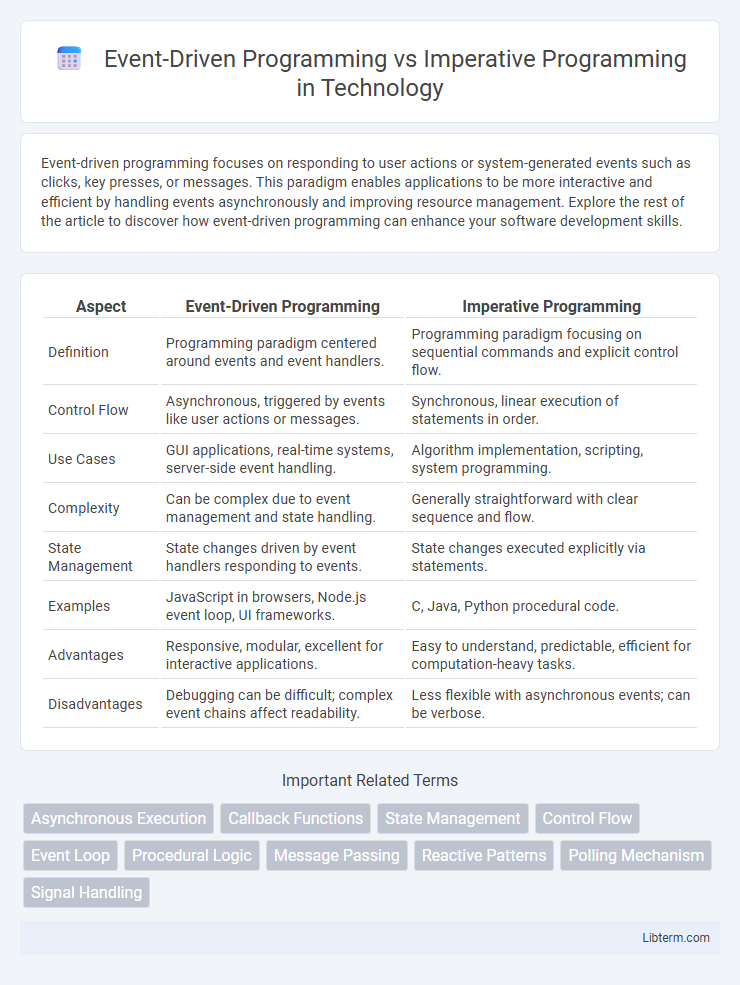Event-driven programming focuses on responding to user actions or system-generated events such as clicks, key presses, or messages. This paradigm enables applications to be more interactive and efficient by handling events asynchronously and improving resource management. Explore the rest of the article to discover how event-driven programming can enhance your software development skills.
Table of Comparison
| Aspect | Event-Driven Programming | Imperative Programming |
|---|---|---|
| Definition | Programming paradigm centered around events and event handlers. | Programming paradigm focusing on sequential commands and explicit control flow. |
| Control Flow | Asynchronous, triggered by events like user actions or messages. | Synchronous, linear execution of statements in order. |
| Use Cases | GUI applications, real-time systems, server-side event handling. | Algorithm implementation, scripting, system programming. |
| Complexity | Can be complex due to event management and state handling. | Generally straightforward with clear sequence and flow. |
| State Management | State changes driven by event handlers responding to events. | State changes executed explicitly via statements. |
| Examples | JavaScript in browsers, Node.js event loop, UI frameworks. | C, Java, Python procedural code. |
| Advantages | Responsive, modular, excellent for interactive applications. | Easy to understand, predictable, efficient for computation-heavy tasks. |
| Disadvantages | Debugging can be difficult; complex event chains affect readability. | Less flexible with asynchronous events; can be verbose. |
Introduction to Programming Paradigms
Event-driven programming emphasizes responding to user actions or system events through event handlers, promoting asynchronous and interactive application design. Imperative programming focuses on a sequence of commands that change program state step by step, providing straightforward control flow and state management. Understanding these paradigms is essential for selecting the right approach in software development based on application requirements and interaction models.
Defining Event-Driven Programming
Event-driven programming is a paradigm where the flow of the program is determined by events such as user actions, sensor outputs, or message passing. It relies on event handlers or listeners that respond to asynchronous events, allowing applications to remain responsive and manage multiple simultaneous activities efficiently. This contrasts with imperative programming, which follows a predefined sequence of instructions to control program behavior.
Understanding Imperative Programming
Imperative programming directs the computer to perform specific sequences of commands to achieve a desired outcome, emphasizing explicit control flow through loops, conditionals, and statements. It relies heavily on detailed instructions that modify program state through variables and data structures, providing a clear, step-by-step execution path. Understanding imperative programming is essential for grasping fundamental coding concepts, as it forms the backbone for many traditional software development paradigms and is contrasted with the reactive nature of event-driven programming.
Core Differences Between Event-Driven and Imperative Approaches
Event-driven programming centers on responding to user actions or system-generated events, enabling asynchronous code execution and improving interactivity, while imperative programming follows a sequential, step-by-step instruction flow that explicitly controls the program state. Event-driven models rely heavily on event handlers and callbacks, fostering decoupled components and responsiveness, whereas imperative models emphasize control structures like loops and conditionals to dictate the program's operations. Core differences include the flow of control, with event-driven programs being reactive and non-linear, contrasted by the linear, state-focused nature of imperative code.
Use Cases for Event-Driven Programming
Event-driven programming excels in scenarios requiring asynchronous user interactions, real-time updates, and distributed systems such as web applications, graphical user interfaces (GUIs), and IoT device control. It allows programs to respond dynamically to external events like mouse clicks, sensor signals, or message queues, enhancing responsiveness and scalability. Industrial automation, chat applications, and serverless architectures leverage event-driven paradigms to efficiently handle concurrent processes and event streams.
Use Cases for Imperative Programming
Imperative programming excels in scenarios requiring detailed control over system state and step-by-step execution, such as system programming, embedded systems, and performance-critical applications. Its straightforward sequence of commands allows developers to manipulate hardware resources directly and optimize algorithms for efficiency. Common use cases include game development, real-time simulations, and tasks involving complex data manipulation or batch processing.
Advantages of Event-Driven Programming
Event-driven programming enhances responsiveness by allowing applications to react instantly to user inputs, sensor signals, or messages, making it ideal for interactive systems and real-time applications. It reduces unnecessary processing and improves resource efficiency by executing code only in response to specific events, unlike imperative programming's continuous instruction execution. This model also promotes scalable and modular code design, as event handlers can be developed and maintained independently, facilitating asynchronous operations and parallel processing.
Advantages of Imperative Programming
Imperative programming offers precise control over program flow, making it easier to understand and debug due to its sequential execution model. It provides straightforward manipulation of state and variables, allowing developers to write clear and efficient code for tasks that require detailed step-by-step instructions. This approach is particularly advantageous in performance-critical applications where explicit control over hardware and memory is essential.
Challenges and Limitations: Event-Driven vs Imperative
Event-driven programming faces challenges in managing complex event flows and debugging asynchronous behaviors, which can complicate state tracking and error handling. Imperative programming often struggles with scalability and code maintainability as program logic becomes tightly coupled and linear, making changes and extensions more difficult. Both paradigms exhibit limitations: event-driven models can lead to unpredictable timing issues, while imperative models may suffer from rigidity and difficulty in adapting to dynamic user interactions.
Choosing the Right Paradigm for Your Project
Event-driven programming excels in applications requiring asynchronous user interactions, real-time updates, and modular event handling, making it ideal for GUI, web browsers, and IoT devices. Imperative programming suits projects demanding precise control flow, clear sequential logic, and computational tasks such as algorithm design, system scripting, or performance-critical applications. Evaluating project requirements, including responsiveness, complexity, and maintainability, guides selecting the paradigm that maximizes efficiency and scalability.
Event-Driven Programming Infographic

 libterm.com
libterm.com